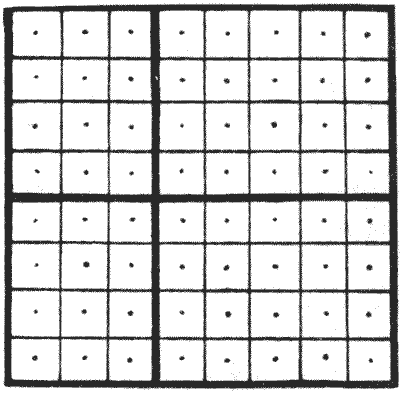We cannot divide the ordinary chessboard into four equal square compartments, and describe a complete tour, or even path, in each compartment. But we may divide it into four compartments, as in the illustration, two containing every twenty squares, and the other two every twelve squares, and so obtain an interesting puzzle. You are asked to describe a complete re-entrant tour on this board, starting where you like, but visiting every square in each successive compartment before passing into another one, and making the final leap back to the square from which the knight set out. It is not difficult but will be found very entertaining and not uninstructive.

Whether a re-entrant "tour" or a complete knight's "path" is possible or not on a rectangular board of given dimensions depends not only on its dimensions but also on its shape. A tour is obviously not possible on a board containing an odd number of cells, such as $5$ by $5$ or $7$ by $7,$ for this reason: Every successive leap of the knight must be from a white square to a black and a black to a white alternately. But if there be an odd number of cells or squares there must be one more square of one colour than of the other, therefore the path must begin from a square of the colour that is in excess, and end on a similar colour, and as a knight's move from one colour to a similar colour is impossible the path cannot be re-entrant. But a perfect tour may be made on a rectangular board of any dimensions provided the number of squares is even, and that the number of squares on one side be not less than $6$ and on the other not less than $5.$ In other words, the smallest rectangular board on which a re-entrant tour is possible is one that is $6$ by $5.$
A complete knight's path (not re-entrant) over all the squares of a board is never possible if there were only two squares on one side; nor is it possible on a square board of smaller dimensions than 5 by 5. So that on a board 4 by 4 we can neither describe a knight's tour nor a complete knight's path; we must leave one square unvisited. Yet on a board 4 by 3 (containing four squares fewer) a complete path may be described in sixteen different ways. It may interest the reader to discover all these. Every path that starts from and ends at different squares is here counted as a different solution, and even reverse routes are called different.
Solutions: 1
This eBook is for the use of anyone anywhere in the United States and most other parts of the world at no cost and with almost no restrictions whatsoever. You may copy it, give it away or re-use it under the terms of the Project Gutenberg License included with this edition or online at http://www.gutenberg.org. If you are not located in the United States, you'll have to check the laws of the country where you are located before using this ebook.